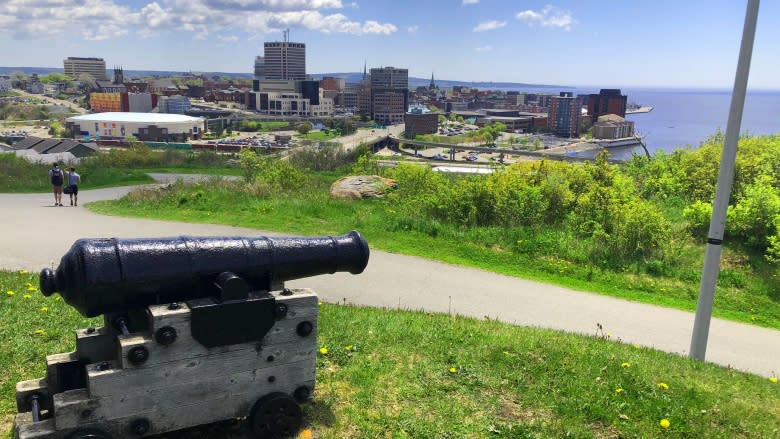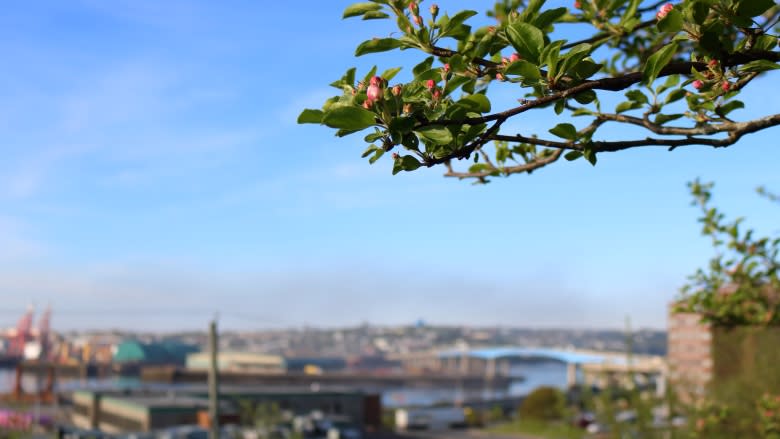Secrets of Fort Howe: From military mystery to 'lover's lane'
Weirdly, for one of the city's major landmarks, Fort Howe doesn't get a lot of love from Saint Johners.
It's best known as the home of the Hollywood Hill-esque Saint John sign that's beckoned to cruise ships since 1999 — and, according to some, for sketchy nighttime activities.
The rocky hillside is cut off from the rest of the north end — hemmed in by a six-lane divided highway and a sprawl of offices, restaurants and budget hotels.
But the site's panoramic views "beckons back to the earliest days of the city," according to Todd Braisted, an American historian and author.
"You have Loyalist House in Saint John, you have Loyalist Days … But the tangible remembrance of the [American] Revolution for the City of Saint John is Fort Howe," he said.
But military history isn't the only interesting thing about Fort Howe.
Most Saint Johners don't know it was the site of a kidnapping, has served as a "lover's lane" and illicit meeting place, housed an observatory with a 20-foot tower and a "time ball," and other weird uses.
Mysterious kidnapping
Any significance Fort Howe had to the Mi'kmaq and Maliseet has, sadly, been lost.
Written records of the site date back to November 1777, when Irish Brigade Major Gilfred Studholme arrived in the Saint John Harbour and constructed a fortification on the hillside with the help of 50 men.
Studholme named the fort after Sir William Howe, commander-in-chief of the British army in America. Howe, while well regarded by his men, according to Braisted — led a campaign in New Jersey that was so rife with looting, rape and other abuses that "some Americans called the British march 'The Rape of the Jerseys,'" Alexander Mikaberidze writes in Atrocities, Massacres, and War Crimes: An Encyclopedia.
(Fun fact: Howe was fictionalized in the supernatural TV series Sleepy Hollow as monster-summoning dark magician.)
By 1783, the site had eight barracks for 100 men, two blockhouses and eight cannons. The compound would have been surrounded by a palisade, or stake wall made of sharpened sticks.
Two years later, the soldiers garrisoned there formed Saint John's first-ever police force, followed by the city's first jail.
One of Studholme's few surviving letters details a "bizarre" incident in September 1783: A party of American soldiers led by Cpt. Jacob Van Buskirk stormed Fort Howe, captured seven soldiers and another man, "and beat them to such a degree that the surgeon feared for their life of one of them."
But unfortunately, Braisted said, "that is where the story ends." The response to Studhome's letter, if there was one, has been lost.
"I wish more of the events had been recorded there," said Braisted. "There are no journals that anyone kept at Fort Howe.
"This is definitely a history mystery."
In 1819, the original barracks were destroyed by a fire, and much of its property sold at public auction in 1823.
The marvellous 'time ball'
By 1870, the remaining original fortifications had disappeared from Fort Howe.
In June of that year, the newspapers celebrated the completion of an observatory on the site — a state-of-the-art building that consisted of two wings with skylights and a 20-foot tower from which a state-of-the-art "time ball" was suspended.
The now obsolete time-signalling device consisted of a large metal ball, dropped daily at 1 p.m., allowing the navigators of ships in the harbour to set their marine chronometers.
An impressive idea — except Fort Howe was too isolated and hilly for workers to maintain the device, and ships in the harbour couldn't see the position of the ball.
The time-ball was moved to the Customs House on Prince William Street, and the observatory, too, fell into disuse. In 1825, a telegraph station built on Fort Howe is recorded as having received signals from Partridge Island.
Failed National Park
It's hard to imagine Fort Howe occupying the same status as Banff National Park or Cape Breton Highlands National Park.
But that's exactly what happened in 1914.
The site was designated a National Historic Park — the first of its kind in Canada — in March of that year, partly at the urging of James B. Harkin, a founder of the Historic Sites and Monuments Board of Canada.
But the national parks service had no experience managing a historic site.
Christopher James Taylor writes in Negotiating the Past: The Making of Canada's National Historic Parks and Sites, that Fort Howe was an "undistinguished property," deemed inferior to others more worthy of inclusion, and "never very successful."
The national park was abolished in 1930, and the site was handed back over to the City of Saint John in 1930.
The site continued to play a part in the defence of Saint John until the Second World War — a legacy that survives in the name "Magazine Street," where the powder houses, or gunpowder magazines, stood until at least 1940.
In 1966, Fort Howe was designated a National Historic Site — but, unsurprisingly, it never rejoined the national park system.
Illicit hookups, dirty deeds
Generations of kids have been warned against hanging out on Fort Howe at night.
A May 1960 newspaper article suggested that police patrols to "keep the romance out of the historic site," described as a "drinking spot" and a "lover's lane."
"It must be kept clean and respectable, especially since the Lookout has been added to the tourist pamphlet, 'Key to Saint John,' which is sent out to all parts of Canada and the United States," the article states.
Keeping Fort Howe "clean and respectable" continues to be a challenge. The site is listed on online message boards as a meeting place for anonymous hookups. It's described on one site as "one of the hottest cruising spots in Saint John."
Like Fort Dufferin in west Saint John, it's also been a target for vandals. In 2015, six-inch howitzer gun used in the First World War was removed after it was filled with garbage, and the plaque honouring the men and women who served stolen.
A handful of plaques and monuments, a full-size 1967 replica of a blockhouse and several 18th-century cannons remain as a testament to the site's military history.
Wide, looping paved roads make Fort Howe less pedestrian friendly than most public parks, which might be one of the reasons fewer people explore it — a shame, according to Braisted, who's spent his career studying forgotten forts.
"If nothing else," he said, "it's a really neat view of the city and the harbour, and you get to learn a little bit about history."







